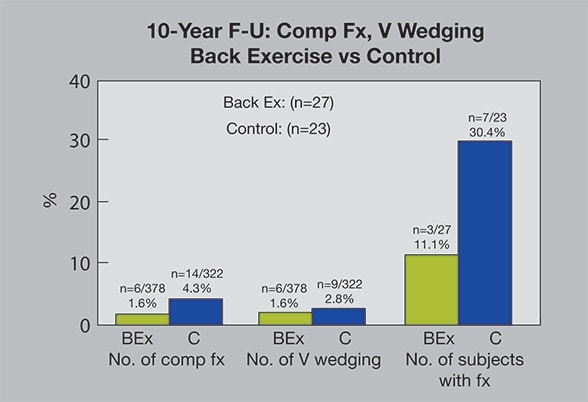Jan. 09, 2016
Bone loss and age-related sarcopenia impair the body's ability to maintain musculoskeletal health. The body's ability to withstand extensive mechanical strain decreases with age. Improving musculoskeletal health in this population is therefore an important step in reducing the risk of fractures, falls and the significant health risks that are associated with reduced mobility.
Mehrsheed Sinaki, M.D., M.S., a physiatrist at Mayo Clinic's campus in Minnesota, initiated and spent more than 30 years evaluating the effect of muscle strength and exercise on bone mineral density, back pain and quality of life. Dr. Sinaki's numerous publications have explored the management of multiple osteoporosis-related musculoskeletal challenges, including back pain, kyphotic posture, vertebral fracture, age-related gait unsteadiness and fall prevention.
Dr. Sinaki and colleagues employ a variety of exercise programs to address these challenges. This article describes two established physical rehabilitation programs they employ and the research upon which the programs are based.
Rehabilitation of Osteoporosis Program-Exercise (ROPE)
Numerous studies have shown the positive effects of engaging in weight-bearing physical activities and confirmed that physical rehabilitative measures play a key role in preventing and managing fractures and their associated complications. Safe straining of musculoskeletal structures with proper physical activities can also reduce the risk of immobility-related deconditioning.
"Programs for preventing and managing osteoporotic fractures are designed to decrease the rate of bone resorption, improve the biomechanical competence of bone and decrease immobility," explains Dr. Sinaki. "The objective of ROPE is to improve patients' quality of life by enhancing muscle strength," says Dr. Sinaki.
A few specific research findings have guided what Dr. Sinaki and colleagues include in ROPE:
- Improvement of back strength reduces the risk of vertebral fractures, back pain and kyphotic posture associated with osteoporosis.
- Stronger lower extremity muscles can decrease the risk of fractures in the lower extremities.
- Bone loss is more significant in the axial skeleton than in the appendicular skeleton.
- Axial trabecular bone loss throughout life is higher among women than men.
Before making any exercise recommendations, Dr. Sinaki recommends performing a complete evaluation to assess the patient's physical, functional, psychological and social status, and to gauge the patient's mobility and ability to perform activities of daily living and exercise.
Depending on the baseline evaluation of the patient's musculoskeletal status, a complete exercise program typically includes weight-bearing aerobic activities for cardiovascular fitness, postural training, progressive resistance training for axial muscle and bone strengthening, stretching of soft tissues and joints, and balance training to prevent falls.
In patients with acute vertebral fractures or chronic pain after multiple vertebral fractures, the goal is to decrease pain and facilitate mobilization as quickly as possible after the fractured area is stabilized. Proper bracing of the spine and reduction of edema in the soft tissues surrounding the fractured area can help reduce pain.
Early but limited use of orthotics, sedative physical therapy (heat/cold, stroking massage) and analgesics can prevent development of chronic pain syndrome. Back supports that promote muscle re-education are preferable over rigid braces. In some patients with refractory pain, kyphoplasty or vertebroplasty performed by experienced practitioners can be effective when combined with rehabilitation measures.
Estadísticas de un estudio de seguimiento de 10 años

Estadísticas de un estudio de seguimiento de 10 años
A 10 años de seguimiento, la incidencia de las fracturas vertebrales por compresión (comp fx) fue de 14 (4,3 por ciento) en 322 cuerpos vertebrales examinados en el grupo de control (C) y de 6 (1,6 por ciento) en 378 cuerpos vertebrales examinados en el grupo de ejercicio de espalda (BEx) (prueba de chi cuadrado, P= 0,0290). V: vertebral. Gráfico reimpreso con autorización de Osteosporosis International (Fundación Internacional de Osteoporosis). 2003;14:773. (Fe de erratas en Osteosporosis International. 2006;17:1702.)
In a retrospective 10-year follow-up study of 50 healthy postmenopausal women published in Bone, Dr. Sinaki and colleagues evaluated the efficacy of ROPE as a tool for managing osteoporosis. One group of 27 women performed ROPE exercises (progressive resistive back-strengthening exercises training on the spine) for two years, while the control group of 23 did not. The researchers found that the relative risk of compression fracture in the control group subjects was 2.7 times greater than in the exercise group.
Spinal proprioceptive extension exercise dynamic (SPEED) program
Patients with kyphotic posture are at increased risk of vertebral wedging and fracture, back pain, and falls. Fear of falls and back fatigue also typically cause these patients to reduce participation in physical activities.
In a study of 25 healthy, physically active women published in Mayo Clinic Proceedings, Dr. Sinaki and colleagues established that a four-week intervention with an inexpensive spinal weighted kypho-orthosis (WKO) and a spinal proprioceptive extension exercise dynamic (SPEED) program significantly improved patients' balance, gait and physical activity level, and reduced their back pain and risk of falls.
According to Dr. Sinaki, application of the WKO increases a patient's perception of spinal joint position, which affects dynamic and static posture. Patients wore the WKO daily for one-half hour in the morning and one-half hour in the afternoon and performed a daily in-home program that included 10 repetitions of back extension exercises for reduction of kyphosis without increasing lumbar lordosis and specific proprioceptive exercises for 10 minutes twice daily to improve balance. The WKO consisted of a fitted harness with 1 kg of weight suspended on the spine between T10 and L4.
"The positive results of these interventions showed us that the SPEED program provides us with an effective tool for managing patients with kyphosis and balance disorder," says Dr. Sinaki.
For more information
Sinaki M, et al. Stronger back muscles reduce the incidence of vertebral fracture: A prospective 10-year follow-up of postmenopausal women. Bone. 2002;30:836.
Huntoon EA, et al. Significantly fewer refractures after vertebroplasty in patients who engage in back-extensor-strengthening exercises. Mayo Clinic Proceedings. 2008;83:54.
Sinaki M, et al. Significant reduction in risk of falls and back pain in osteoporotic-kyphotic women through a spinal proprioceptive extension exercise dynamic (SPEED) program. Mayo Clinic Proceedings. 2005;80:849.